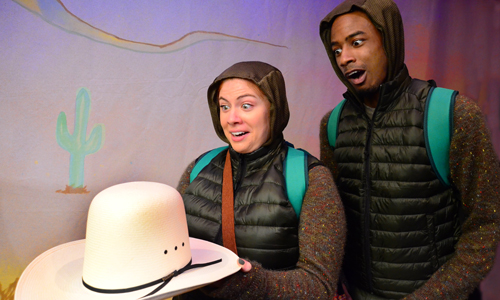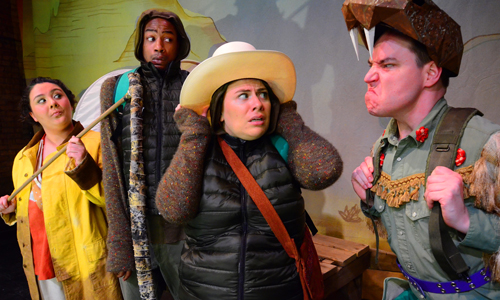, http://lifelinetheatre.com/performances/18-19/hat/we-found-a-hat-study-guide.pdf,
From Rescripted
‘We Found a Hat’ Takes the Wisdom of Sharing to the Preschool Crowd
January 31, 2019
By Hallie Palladino
Lifeline Theatre’s musical adaptation of Jon Klassen’s children’s book, We Found a Hat, shows a friendship put to the test. The play, adapted by Jessica Wright Buha and directed by Manny Tamayo follows two turtles, Sizi (Amanda Roeder) and Kai (Terry Bell), on a journey from their summer habitat to their winter burrow. To get there they must traverse a perilous desert. A meddling Cactus (Scott Sawa) makes a bet with the optimistic Sun (Gabriella Fernandez) that he can drive a wedge between these close friends. The setup has echoes of the devil betting God he can throw Job off his goodness game. The turtles unwittingly fall victim to this mean-spirited social experiment designed for The Cactus’s entertainment. The Cactus, personified as a menacing cowboy with a southern drawl and an excessively large hat, takes off said hat and leaves it in the path of the turtles, jumpstarting the conflict of the play.
Structured like a classic road story, the turtles face a series of obstacles on their journey. Wearing the hat gives them newfound confidence and soon they start attributing their own successes to this seemingly magical hat. The turtles try a number of strategies that will be familiar to young children as they negotiate over the hat, which makes them both look amazing of course. These include taking turns with the hat, and having a finders keepers argument. As we would hope, they decide their friendship is more valuable than this exciting new piece of headwear.
As always, at Lifeline the magic of theater is made accessible to young audiences through the simple and transparent art of make believe. The successful design in this production including Emma Cullimore costumes and Joe Schermoly’s scenic design is in keeping with this well-established aesthetic, although unfortunately the music in this show isn’t as memorable or successful as the music in other recent Lifeline shows.
Like Klassen’s picture book, beloved by toddlers and preschoolers, this particular play will be most enjoyed by children in the under five age group. The show addresses problems that are relevant to their lives such as the difficulties of sharing and getting along with friends. The frustration of being very small and rather slow in a world full of obstacles (life as a turtle) mirrors the experience of life as a toddler.
The experience of going to Lifeline, however, is always warm and welcoming. There are cosy blankets on every seat for kids to cuddle up with, and the cast signs autographs in the lobby for their adoring new fans. But perhaps the best kept secret about Lifeline is their Stories Come Alive Program. For $5 kids can do an hour long drop-in theater class at noon on certain show days, and parents are welcome to either stay, or take a little time to themselves (pro-tip the theater is a block from Roger’s Park’s beloved Heartland Cafe).
As a parent who has been attending Lifeline loyally for years I’m excited to see the continuation of the company’s commitment to developing original children’s programming going strong under the new artistic leadership of Ilesa Duncan. Children’s theater fills a vital role in audience development that cannot be overstated. And I’m sure the fact my kindergartener recently insisted on signing up for musical theater after school has everything to do with the fact she’s attended the past three seasons at Lifeline.
From ChiIL Mama
January 15, 2019
By Kimberly Robb Baker
Lifeline Theatre’s production of We Found A Hat was the most pleasant family theatre experience I’ve had in the last year. Specifically, it’s the first production my four-year-old hasn’t had to leave early, yet my older kids had a blast as well.
The universal appeal was in the cleverness of the production and also in the fact that it’s a theme anyone can relate to: loved ones driven apart by desire and jealously. In this case two best-friend tortoises have their friendship challenged when, as they migrate through the desert, they come upon a hat that instills confidence and looks great on each of them.
When I say the production was clever, I mean that we bought into the story exactly because the reality of being a bunch of audience members nearly head-to-head with a small group of actors on a stage the size of my living room with little kids occasionally making their loud contributions—well, they embraced all of that and made it part of the story.
For example, the actors made a show of getting the set ready while people were settling in their seats. This was a nice pre-show to get us interested in what was to come and entertain little ones who are not known for sitting in a seat and staring at nothing—even for five minutes.
Inventive costumes (e.g. the fringe on a cowboy’s jacket and chaps standing in for cactus prickles and a sun/moon costume that enables one actor to quickly shift between embodying each of the celestial objects—oh, and such a cool snake costume/puppet!) and use of props and actor’s bodies allowed us to delve into a vivid world of friendship being tested in the dramatically changing elements and landscape of a long desert journey.
Some of our favorite scenes were the cactus gauntlet, a really cool dream sequence, and a dangerous storm (it was just scary enough—my 4-year-old was more afraid of the hand dryer in the bathroom).
The actors threw themselves wholeheartedly into this ecosystem of inventiveness. Through the turtles (played by Terry Bell and Amanda Roeder), kids got to see the struggle of being the big or little one, of being labeled as creative or practical when your heart wants to explore all the possibilities of who you are.
Gabriella Fernandez played Sun and Moon against Scott Sawa’s Cactus, and the two did a skilled and joyful job of embodying multiple elements and acting as a Greek chorus to give us some context on the tortoise’s friendship.
They also taught us a bit about migration, water in the desert, and the difference between turtles and tortoises. Your older children might groan before and after the show that it’s for little kids, but my 10-going-on-30-year-old caught my eye several times as we shared embedded jokes meant for the older members of the audience, and he got in line to have his program signed after the show.
When my teens were tots, we were annual Lifeline Theatre KidSeries season subscribers. We’ve adored their amazing, original book based adaptations for decades. Their production values are excellent and they’re one of our favorites for introducing young children to their first live theatre offerings. They truly are a lifeline for families, bringing stellar stories to life on stage, and often fostering a lifelong love of theatre arts.

















